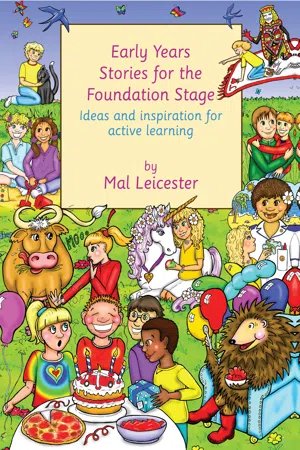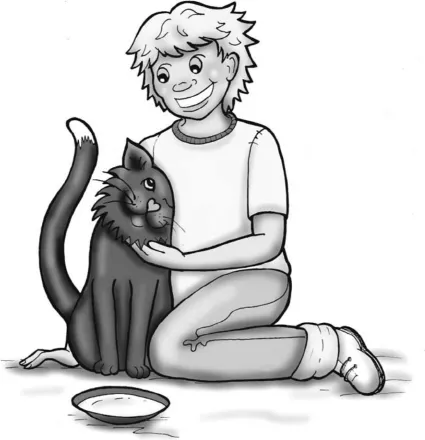Chapter 1
Was She There?
Teacher’s Notes
Theme One: Caring for Animals and Plants (including our pets). Young children need to understand that their pets can feel pain and be hurt, just as they can themselves.We can learn how to look after them.
Associated Values: Kindness; Respect. Respect for living creatures should include a disposition to be kind in our treatment of animals combined with a sensible appreciation that an animal, wrongly approached, can be dangerous.
Associated Emotions: Affection. Young children can readily come tofeel fond of their pets and can be encouraged to develop a kind, helpful, caring disposition in relation to dependent and vulnerable creatures (including younger/smaller children).
Associated Relationships: The theme and story are rich in relationships: with the self (being a kind person); with another creature (such as a family pet); with a caring adult (Danny’s mum); with the environment (of our home).
Early Years Teaching
Early Years Experiences: This theme of caring for animals and plants readily taps into early years experiences of pets and other creatures – their food, houses, appearances, behaviour. This particular story also explores the common experience of losing something we value.
Early Years Topics: This first chapter contains relevant material for teachers exploring the following topics: Ourselves (My Pet; My Home; My Family); The Environment (Our Homes); Plants and Animals: (Our Pets; Other Animals; Animal Noises; Plants and the Countryside).
Early Years Skills: The Six Learning Domains. Pages 10–14 provide learning games and activities for each of the early years foundation areas. These are all linked to the story and its associated theme.
Session Plan: Caring for animals and plants
This timescale is provisional only. Feel free to “go with” the children’s own pace. Above all, adapt the material to suit your particular group of children. There is a big difference in teaching a group of three-year-old children and a group of five-year-olds, or a mixed age group, and between teaching one or two children or a bigger group.
1 Introduce the story 2–5 minutes
Introduce the theme 3–5 minutes
2 The story 5–10 minutes
The teacher shows the illustration and suggested objects before reading the story. The story can be retold in several sessions, to be followed by a different learning activity each time. Children enjoy listening to a familiar story and may absorb new aspects each time.
3 Talking about the story; associated stories and rhymes 5–10 minutes
The teacher uses some of the questions and discussion points given, stimulating the children to talk about the story/theme. Additionally, there are further story, poem and song suggestions provided, and a relevant traditional poem or nursery rhyme.
4 Learning games and activities 5–30 minutes
For each story, learning activities in each of the six learning domains are provided. There is also a “co-operative poster” to be made and/or enjoyed.
Total time 20–60 minutes
1 INTRODUCE THE STORY AND THEME
To introduce the story
● The teacher tells the children that the story is about Danny and his new pet cat.
● The cat is called Marbles because she has bright green eyes. The teacher shows the children some glass marbles.
● The teacher shows the children the illustrations for the story.
To introduce the theme
● The teacher asks the children about their pets. What are they (dog, cat, rabbit, etc.)? What are their names? Ask the children who do not have a pet what they would like to have, if they could.
● Talk about how we treat our pets, for example, by being kind and gentle, not mean or rough.
● Talk about how we look after different pets. What do dogs eat? What about cats? How do we care for plants?
Additional points
● As you tell the story, once again show the two illustrations provided.
● Shake your head to indicate that the children can shout “No” to the various hiding places.
● Read it again now that the words are familiar and to allow the children to join in with each “No”.
2 THE BASIC STORY:
Was She There?
“Here is a new pet,” said Daddy.
It was a black cat. Her name was Marbles.
Marbles fell fast asleep. Danny poked her.
“Boo,” he shouted.
Marbles was frightened. She ran away. Danny couldn’t find her. He was sad.
At tea-time Mummy and Danny heard a noise from inside the piano. It was Marbles. Mummy lifted her out.
Danny gave Marbles some milk. He stroked her. He was happy to have her back again.
2 THE ADVANCED STORY:
Was She There?
Was She There?
When Danny was five his daddy brought home a small black cat. She had a red collar and a white tip to her tail.
“Did she dip it in paint?” Danny said.
Mummy laughed and shook her head.
“What will you call her?” she asked.
Danny looked at his cat. Her round eyes shone like green marbles.
“Marbles,” he said.
Marbles curled up and went to sleep. Danny wanted her to wake up. He poked her.
“Boo, Marbles,” he shouted.
Marbles hissed at Danny and ran from the room as fast as she could.
Danny and Mummy searched the whole house to find her.
Was she under the table?
No.
Was she under the beds?
No.
Was she in the cupboard?
No.
Was she in the toy box?
No.
Was she behind the chairs?
No.
She was nowhere to be seen.
“You made her jump, Danny. It frightened her. She must have run away,” Mummy said.
Danny was sad all day long. Mummy gave him a big hug.And then, they heard a thud from inside the piano. Danny and Mummy looked at each other in surprise.
Mummy reached her arm down the gap in the back of the piano. Her fingers felt something soft as fluff and she lifted it out. It was Marbles.
Mummy gave Marbles a saucer of milk. Danny watched her lap it all up with her tiny pink tongue. After that, Danny stroked her very gently.
“I’m sorry I frightened you, Marbles,” he whispered.“I won’t ever boo you again.”
Danny stroked and stroked Marbles and she began to purr. It was a happy sound which Danny liked. He was very happy too. He and Marbles had made friends.
3 TALKING ABOUT THE STORY
The teacher and children talk about the story:
● How old was Danny?
● What did Danny’s cat look like?
● Who has a pet? What colour is your dog, cat, rabbit, etc.?
● Has your pet ever been lost? Was it found?
● Have you ever lost anything else? What was it? How did you feel? Was it found?
● How did Danny frighten Marbles?
● How was he kind to her later?
● What is mean to do to your pet?
● What is kind to do to your pet?
Note: With older pre-...


